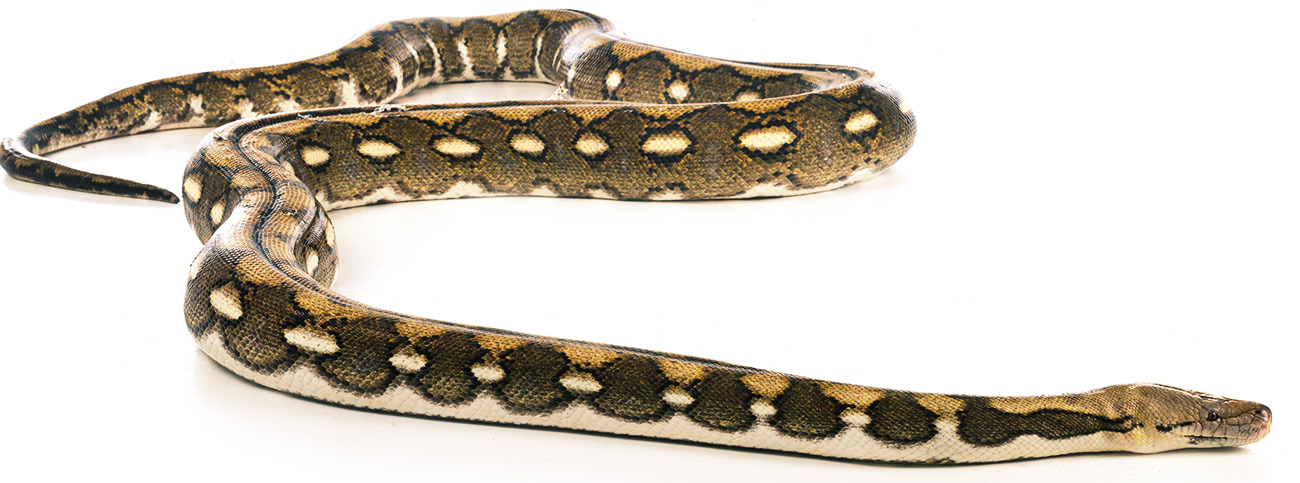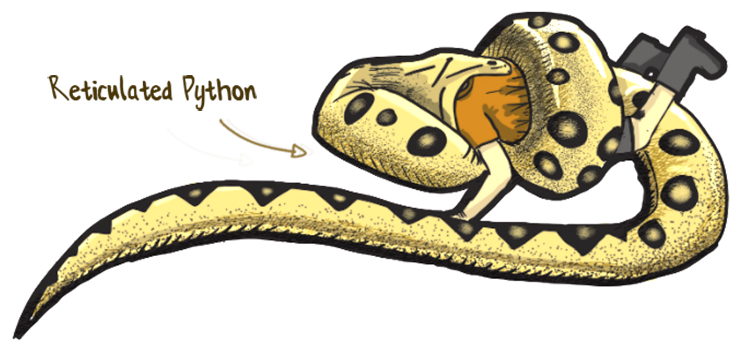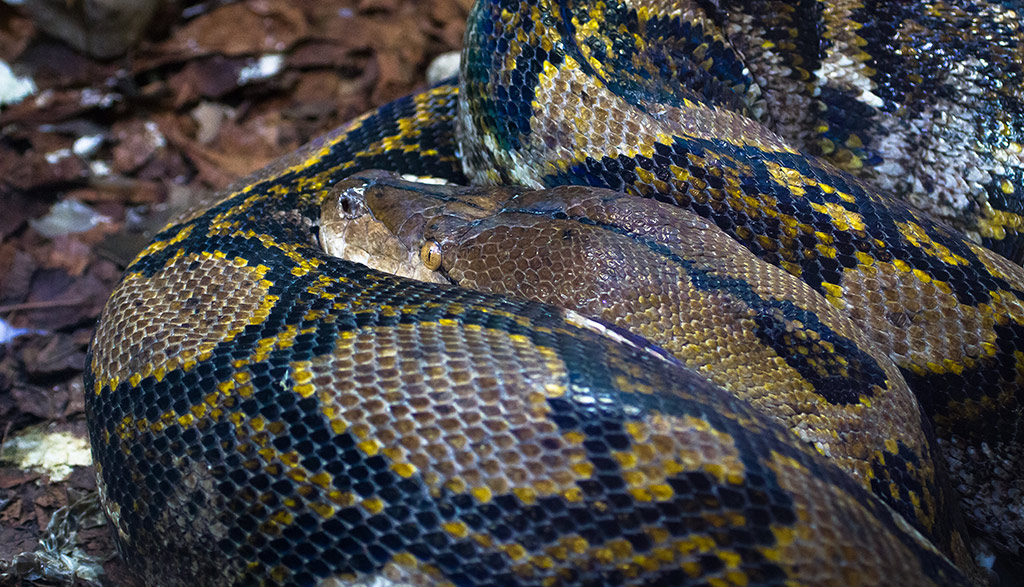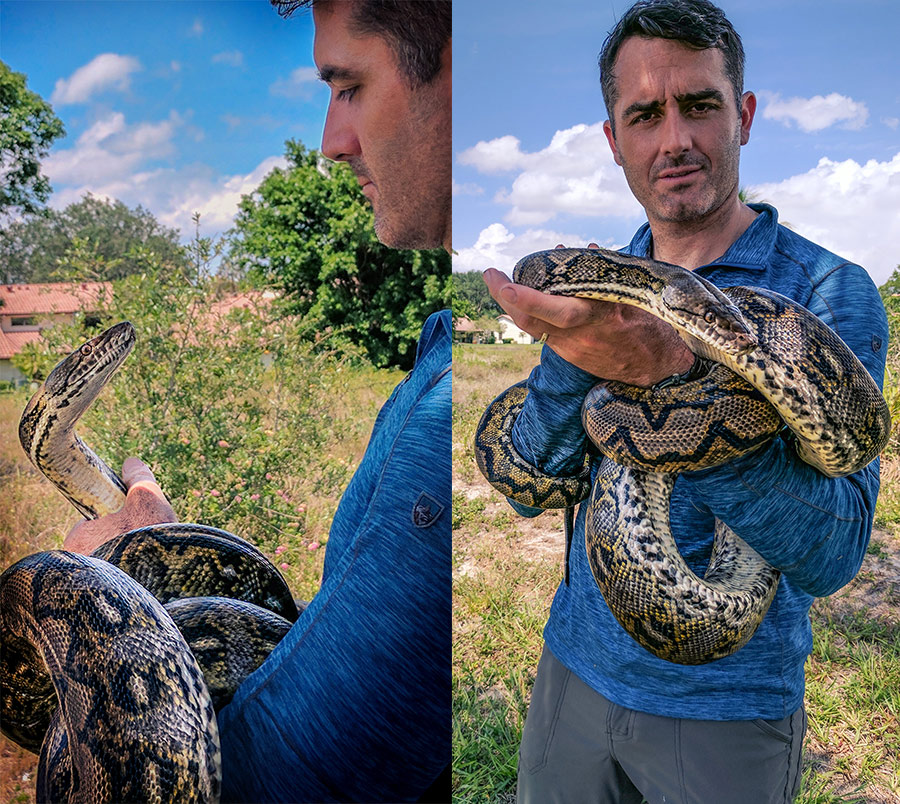Surviving a Reticulated Python or Constrictor Snake


The Basics of Constrictors
The reticulated python is one of the few snakes in the world that can lay claim as a man-eater. I don’t say that just because it has a certain ring to it. There is a huge difference between a man-killer and a man-eater. Rhinos can kill humans, but they don’t eat them. Plenty of venomous snakes also kill people and none of them actually eat the humans they kill.
We’re talking about a snake that can grow large enough to not only kill a person, but could stick around to literally swallow them whole. That’s a scary thought!
Burmese Pythons, Anacondas and Rock Pythons are other constrictors that could also be potential man-eaters, given their size. Luckily, we’ve only had a single recent documentation of a reticulated python eating a fully grown man, so let’s concentrate on them.
Which snake is the biggest?
How do we measure the biggest snake? Reticulated pythons are not the longest snake to have ever lived – the extinct Titanoboa currently takes that trophy at over 42’ long. They’re not the heaviest either – anacondas claim that title at over 500 pounds. The reticulated python does, however, hold the record for the world’s longest snake living today. Biologists tend to agree that this snake could reach lengths of around 30 feet. However, no snake has been officially measured that long, and large specimens of these species are becoming increasingly rare due to urbanisation and illegal poaching for the pet trade.
The Guinness book of world records lists the largest officially measured living snake as Medusa – 25 ft 2 in. Oddly, it also lists the largest one ever caught in Celebes, Indonesia in 1902 at 32.75 feet – even though many scientists are skeptical of this historical report and think the longest ever may be a bit smaller.
Reticulated Pythons can eat an adult human
Everyone always thinks constrictors like the reticulated python kill through suffocation. That is simply not true.
I hosted an Animal Planet show where I investigated the python that swallowed a young man named Akbar on the island of Sulawesi. In the show, I worked with physiologists who studied the power of these snakes. We were able to test a massive Sulawesi reticulated python in a lab setting. By placing pressure sensors inside its next meal (a large pig), we could see that the suffocation myth was busted.
When you crunch the numbers, the limiting factor is the flow of blood to the brain, not how long you can survive without breathing. If these snakes cut off blood supply quickly, the prey die much faster. It’s a bit like putting a giant tourniquet on your whole body.

The best evidence we have of these snakes being able to eat people is cell phone footage from Sulawesi that shows a 23 foot reticulated python that had the body of a 25 year old farmer named Akbar inside.
Now consider the fact that at 23’ these snakes can be man eaters and that they can get upwards of 30+ feet long. Given that large constrictors like this have been living with humans for thousands of years, it means the largest of these snakes probably could have it out for us. If nothing else, if we’re within the size range of prey they eat, we could be on the menu. From our perspective, it’s an age old cat and mouse game, whose predatory danger has likely been passed down through generations in our mythical stories.
The big question for us to consider today is: Are these snakes a problem we should worry about?
The short answer is no, unless you live in the jungles of southeast Asia. The long answer is that you shouldn’t dismiss these snakes as harmless. They’ve had us on the menu for a while now. This is even more important to remember if you happen to have one as a pet.
There are plenty of things you can do to avoid an attack and get yourself out, if only you know how. So let’s learn how.
SCENARIOS TO AVOID with Constrictors
Walking blindly in the underbrush!
The reticulated python gets its name for the “reticulated” or netlike pattern on its back. It is an impressive camouflage, and chances are you won’t see them if you’re bushwacking your way through the forest. Reticulated pythons in the wild tend to look a lot like this.
They are sit-and-wait predators that essentially just wait for their prey to come by. And that could be you if you’re not careful.
Don’t get bitten
Take note that reticulated pythons here have 80 dagger-like backward facing teeth in 6 rows in their mouth. The teeth are designed to not let you go. It forces their prey to only move in one direction – into their mouths. Remember, even small pythons can cause nerve damage in your hand via the physical damage from the bite. Don’t rip the snake’s mouth off as it bites. That could cause a huge laceration. The snake has to choose to let go.
Don’t let it wrap you up
Getting bitten is only the beginning. The real danger comes from the constricting power of these snakes. In less than a second from the bite, the python will get its first coils around you in an instinctual attack pattern. It twists and spins, disorientating you until it has you locked up completely. Keeping the coils off seems to be the key.
Don’t Wander Alone
While having a buddy is always a good thing in the wild, it’s particularly important with constrictors. If you have a friend nearby, they can pull the snake coils off or beat the snake until you’re free. Without a friend nearby, you’re in much greater danger. You’ll have to resort to other methods of freeing yourself.
Carry a stick or blade
Truth be told, no animal likes to get hurt. Pythons aren’t covered in a plate of armor either so if you do get attacked, a sharp object is going to help you get free.

Python Recap
- Walk in areas that limit the hiding places of a would-be snake.
- Don’t walk around in heavy brush at night.
- Don’t wander alone into the bush in reticulated python country.
- Don’t let your kids or pets wander around alone in python country as they’re easier prey.
5. Avoid picking up a large constrictor like this by yourself. Even if you do pick it up safely, they have a tendency to wrap up prey quickly – and it’s really hard to get out. For perspective, handlers generally go with the one person per meter rule when dealing with large pythons (but don’t go picking one up yourself without an experienced person nearby).
How to Survive A Constrictor
Besides trying not to be in the wrong place at the wrong time, there are some things that will get you out of a sticky situation should you get wrapped up.
Let’s just assume here, you’ve been attacked and the snake is starting to wrap you up.
- Don’t let it wrap you up. Keep your hands and arms free. Try to get the coils off quickly.
- Control the head. If you have a friend with you, have them grab the head and you can start unwrapping coils.
- If it’s just you, I guess it’s war now. Do whatever you need to get free. Just know the more you struggle, the tighter it squeezes – it’s instinct.
- If you have a knife or sharp stick, get it out fast. Preferably having a lanyard on your wrist or neck will help prevent you from dropping it.
- If you happen to have mouthwash or alcohol in your shirt pocket, you could splash it on the snake’s face and mouth. They hate that.

The Take-home
Pythons, anacondas and other large constrictor snakes have been evolving with us for millenia. Most of them don’t get big enough these days to eat an adult, but that doesn’t mean we should be complacent around them.
Let us also not forget that pythons have tremendous value to the habitats they live in and for humans. For instance, they keep rat populations down which otherwise could spread fleas and disease. Those same rats might eat stored grain, which is a real problem in developing countries. Maybe it’s better to think of a python around the house as a gift.
While they’re somewhat dangerous when they’re big, we can actually live in harmony with them, if only we take a few precautions when we’re in their habitats!
Prefer to listen?
I’ve recorded this short audio version of this info about avoiding and surviving python attacks. I hope you enjoy.

